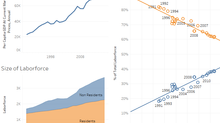Less Is More: Mastering the Science of Simplified Data Stories

The Problem with Data Overload
Imagine this: You’re sitting in a meeting, staring at a dashboard crammed with numbers, charts, and tables. The presenter flips through slide after slide, but instead of clarity, you feel overwhelmed. Sound familiar? In today’s data-driven world, organizations are drowning in information—but insights remain elusive.
The challenge isn’t just presenting data; it’s making it actionable . At FYT Consulting, we believe the key lies in simplifying your data while preserving its core insights. This is where data storytelling comes in—a skill we’ll help you master in our upcoming Data Storytelling Workshop.
Why Simplicity Matters
Humans aren’t wired to process endless rows of numbers or overly complex charts. Instead, we respond best to clarity and focus. A simplified approach ensures that your audience:
Understands the problem at hand.
Grasps the implications of the data.
Knows exactly what actions to take next.
Take the example of EATMORE Restaurant , a client we worked with recently. Their sales data was scattered across multiple dashboards, making it hard for management to identify trends. By simplifying their data into a clear narrative—highlighting falling revenues, shifting customer behavior, and actionable recommendations—we helped them turn overwhelming complexity into a coherent plan for growth.
How to Simplify Your Data Effectively
Simplification doesn’t mean dumbing down your data; it means distilling it into its most impactful form. Here are three strategies to get started:
Focus on the “Big Picture”
Before diving into details, ask yourself: What’s the one thing my audience absolutely needs to know? Use this as your North Star to guide every aspect of your presentation. For instance, instead of showing year-over-year sales figures for every product category, highlight the top two categories driving growth—and explain why they matter.
Use Visualizations Wisely
Not all charts are created equal. Some, like pie charts and stacked area graphs, can confuse rather than clarify. During the workshop, we’ll teach you how to select the right visualization for your specific message—whether it’s a bar chart for comparisons, a line graph for trends, or a scatter plot for correlations. Remember, the best visual is the one that makes your point instantly clear.
Prioritize Actionable Insights
Every piece of data in your presentation should serve a purpose. If it doesn’t directly support your main takeaway, cut it. For example, if your goal is to recommend cost-cutting measures, focus on areas where expenses have spiked—not on unrelated metrics like employee satisfaction scores.
A Framework for Streamlining Your Data Story
To simplify effectively, follow the PAST, PRESENT & FUTURE framework, which we cover extensively in the workshop:
Past : What happened? Identify the root causes of the issue using historical data. For EATMORE, this meant analyzing declining guest numbers over time.
Present : Where are we now? Highlight current challenges and opportunities. For EATMORE, this included recognizing their shift from a weekend hotspot to a weekday-focused venue.
Future : What could happen if we act—or don’t? Paint a vivid picture of potential outcomes to motivate your audience. For EATMORE, this involved projecting revenue losses if no changes were made.
This structure not only organizes your thoughts but also keeps your narrative focused and engaging.
Common Pitfalls to Avoid
Even well-intentioned efforts to simplify can go awry if you’re not careful. Watch out for these common mistakes:
Overloading visuals : Too much information on a single slide can confuse your audience. Stick to one key insight per visual.
Neglecting context : Numbers alone rarely tell the full story. Provide enough background to help your audience understand the significance of the data.
Failing to connect emotionally : Facts may inform, but stories inspire. Use anecdotes, examples, or analogies to humanize your data and make it relatable.
For example, imagine presenting declining customer retention rates. Instead of bombarding your audience with raw percentages, frame the issue as a story: “If this trend continues, we risk losing $X million in revenue within the next year.” Suddenly, the data becomes urgent and actionable.
Level Up Your Data Simplification Skills
Ready to transform your data overload into a powerful tool for influence? Join us in the Data Storytelling Workshop , where we’ll walk you through hands-on exercises to master the art of simplification. You’ll learn how to:
Prioritize insights that drive action.
Choose the right visuals to convey your message.
Craft compelling narratives that resonate with any audience.
Don’t let complexity stand in the way of action. Sign up today and discover how to simplify your data without sacrificing impact!


























Comments